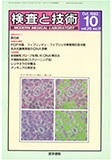Japanese
English
- 有料閲覧
- Abstract 文献概要
持続性の蛋白尿を伴うネフローゼ患者はアテローム性動脈硬化症を促進したり,腎疾患の悪化をさらに速く進行させたりするさまざまな脂質代謝異常を併せ持つことが多い.われわれはこれらの患者にみられる高脂血症が,食餌の操作だけで改善することができるかどうかを究明することを試みた.
それぞれの患者を通常食で8週間の基礎コントロール期間を経た後,長期にわたって持続した高度の蛋白尿(5.9±3.4g/24時間)および高脂血症(平均コレステロール8.69±3.34mol/l)を伴う20名の未治療の慢性糸球体疾患患者に8週間にわたって菜食主義者の大豆食を摂食させた.この食事は脂肪(総カロリーの28%)と蛋白質(0.71±0.36g/kg理想体重/日)が少なく,コレステロールがなく,そして一価不飽和と多価不飽和脂肪酸(多価不飽和酸/飽和酸比2.5)および線維(40g/日)が豊富であった.この食餌療法期間後に患者には再び8週間にわたって通常の食事を8週間食べさせた(洗い出し期間).大豆食期間中血中コレステロール(総,低比重,高比重リポ蛋白),アポリポ蛋白AとBは有意に低下したが,中性脂肪濃度には変化がなかった.尿中蛋白排泄は有意に低ドした.すべての脂質分画濃度および尿蛋白の量は洗い出し期間中にもとの量に逆戻りする傾向にあった.
Nephrotic patients with persistent proteinuria also have various lipid abnormalities that may promote atherosclerosis and more rapid progression of renal disease. We aimed to find out whether dietary manipulation can correct the hyperlipidaemia found in these patients.
After a baseline control period of 8 weeks on their usual diets, 20 untreated patients with chronic glomerular diseases, stable long-lasting severe proteinuria (5.9 [SD 3.4] g/24 h) and hyperlipidaemia (mean serum cholesterol 8.69 [3.34] mmol/l) ate a vegetarian soy diet for 8 weeks. The diet was low in fat (28% of total calories) andprotein (0.71 [0.36] g/kg ideal body weight daily), cholesterol free,and rich in monounsaturated and polyunsaturated fatty acids (polyunsaturated/saturated ratio 2.5) and in fibre (40 g/day). After the dietperiod the patients resumed their usual diets for 8 weeks (washoutperiod). During the soy-diet period there were significant falls inserum cholesterol (total, lew-density lipoprotein, and high densitylipoprotein) and apolipoproteins A and B, but serum triglycerideconcentrations did not change. Urinary protein excretion fellsignificantly. The concentrations of all lipid fractions and the amountof proteinuria tended to return towards baseline values during thewashout period.
Copyright © 1992, Igaku-Shoin Ltd. All rights reserved.


